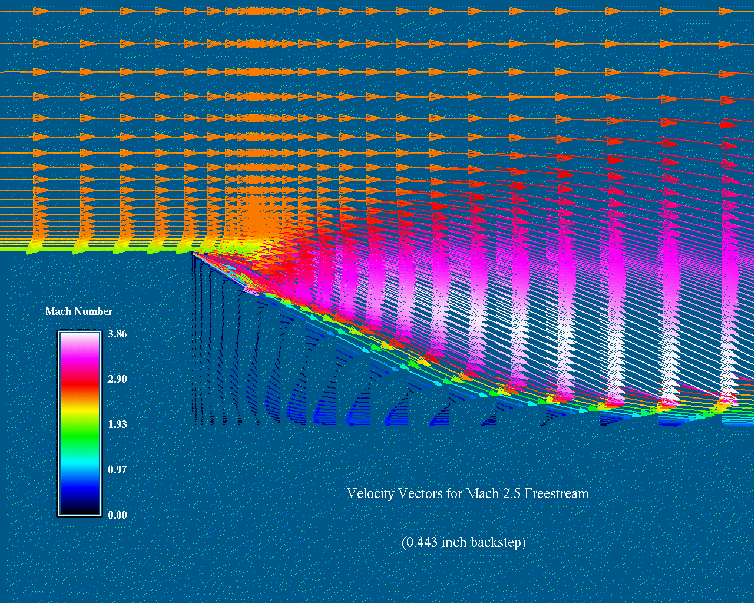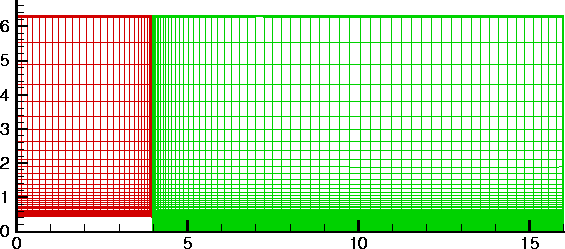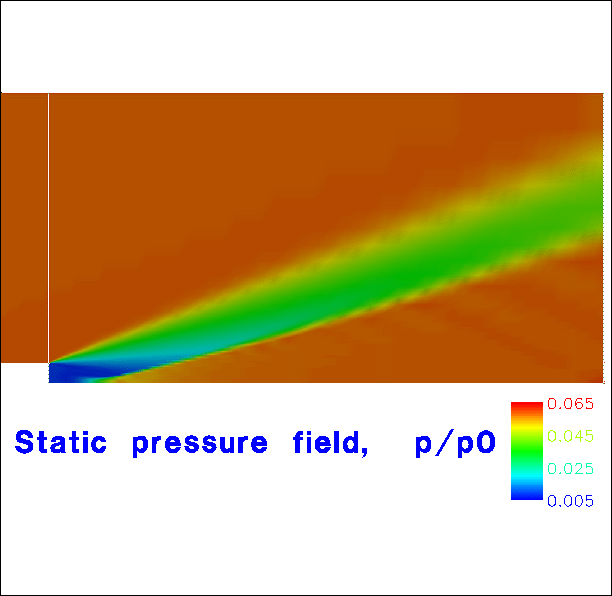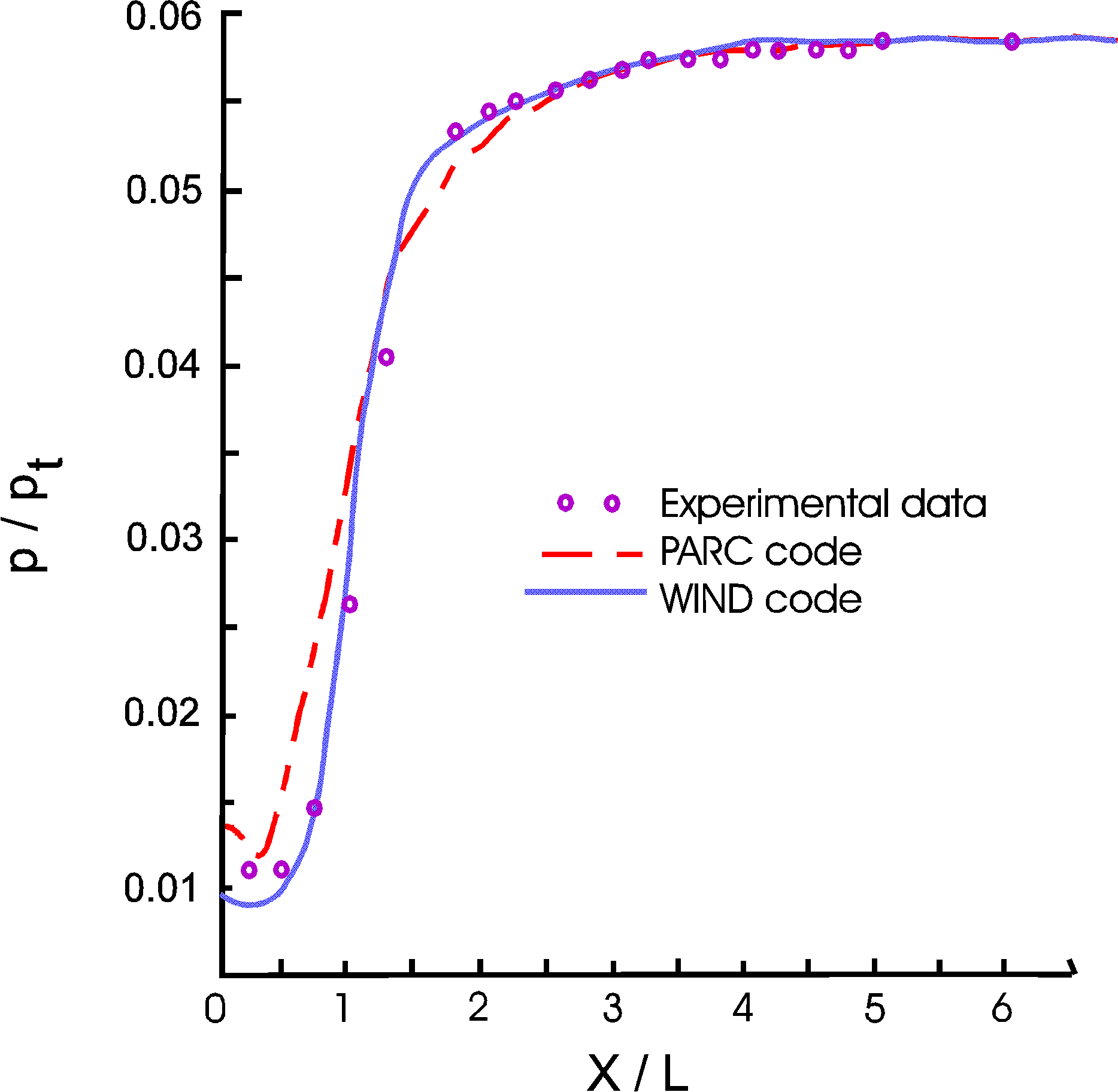

The WIND code was validated relative to rearward-facing step measurements for the supersonic flow of a perfect gas. The rearward-facing step condition provides a fundamental test case to evaluate CFD code predictions of the expansion fan region between the free stream flow and the reattachment shock, the compression effect of the shock, and the relatively constant pressure area between the reattachment shock and shear layer. The WIND code with zonal boundary conditions was exercised to determine the supersonic flow over the geometry shown below, and compared with data as presented by Smith (Ref. 1). The test case selected was for an inlet flow Mach number of 2.5 (Re=460,000/in.). At these tunnel conditions the flow should be laminar over most of the upstream plate. Transition to turbulent conditions should take place in the shear layer over the backstep.
All of the archive files of this validation case, including script input files referenced below, are available in the Unix compressed tar file RearwardStep.tar.Z. The files can be accessed by the commands:
uncompress RearwardStep.tar.Z
tar -xvof RearwardStep.tar
The rearward-facing step height was 0.443 inches. The domain modeled extended 4.0 inches upstream of the step, 12 inches downstream of the step, and 6.25 inches above the step.
The grid was divided into two computational domains with continuous grid lines across the boundary. The upstream domain was modeled with an I=30 x J=40 grid (I streamwise, J normal to the wall). The downstream domain used a 60x79 mesh. The first point off the viscous walls corresponded to a y+ value of approximately 1.0.

The following boundary conditions were set:
The initial Conditions were:
The computational strategy was to start the flow above the step in zone 1 and zone 2 at the freestream static pressure, temperature, and Mach number, while the flow behind the step, zone 2, was initialized as no flow at the freestream static conditions. This initialization was intended to allow the step recirculation region to develop without causing problems on the step backward facing wall. The full implicit solver was used with local time stepping at a CFL number of 0.40.
The "ARBITRARY INFLOW" block is for initialization purposes only, and is ignored when the solution is restarted, i.e., when a valid .cfl file already exists.
The computation was executed on an SGI Indigo 2 running the version 5.3 compiler. The WIND code was run via the WIND script, and specifying the default code version. The response to all requests for file names, i.e. .dat, .cgd, .cfl, .lis, was the root name "back" (note the input file name above). The default solver was used to perform the computation using the SST turbulence model to compute the turbulent stress. Implicit boundary conditions were used. The zone 1 flow variables were converged to an L2 residual of 6.6e-06 with the turbulence variables converged to 6.4e-08. The zone 2 flow variables were converged to 2.0e-04 with turbulence variables converged to 3.2e-07.
Graphical results were obtained using FAST. A PLOT2D grid file was obtained using the b4wind program to convert the back.cgd file to an unformatted plot2d file named back_2zone.p2d. Two PLOT2D solution files were created using the cfpost program. The first file is created by typing cfpost < cfpost_flo.inp. This produces a standard PLOT2D solution file, back_prt.2d. A second PLOT2D solution file is created by typing cfpost < cfpost_prt.inp which creates a file, back_prt.2d, which contains the velocity magnitude, the static pressure normalized by the freestream stagnation pressure (see next figure), the temperature, and the density.

The validation parameters selected for the study were the surface static pressures downstream of the step and the location of the reattachment compression shock. The surface static pressures predicted by WIND using the two-equation SST turbulence model are shown below. This figure includes comparisons calculated by an early version of NPARC (Ref. 2) and WIND with experimental data. The WIND code slightly over-predicted the surface pressure drop from the free stream value to the corner value in the separation region (base pressure) by approximately 5 percent. This probably occurs due to the fact that the transition point is experimentally unknown and not accurately predicted by the natural transition of the turbulence model. However, this over-prediction is closer to the experimental results than previous pressure drop under-predictions using the AEDC PARC, TUFF, and GASP codes (Refs. 2 and 3) which used the Baldwin Lomax, K-E, and Cebeci and Smith models, respectively. The remainder of the WIND pressure prediction is in excellent agreement with the predicted pressure.

No sensitivity studies were run for this example case.
2. Garrard, G. D. and Phares, W. J., "Calibration of the PARC Program for Propulsion-Type Flow," AEDC-TR-90-7 (AD-A224253), July 1990.
3. Ebrahimi, H. B., "CFD Validation and Evaluation for Reacting Flows, Part III", AIAA-95-0735, Reno, NV, Jan 1995.